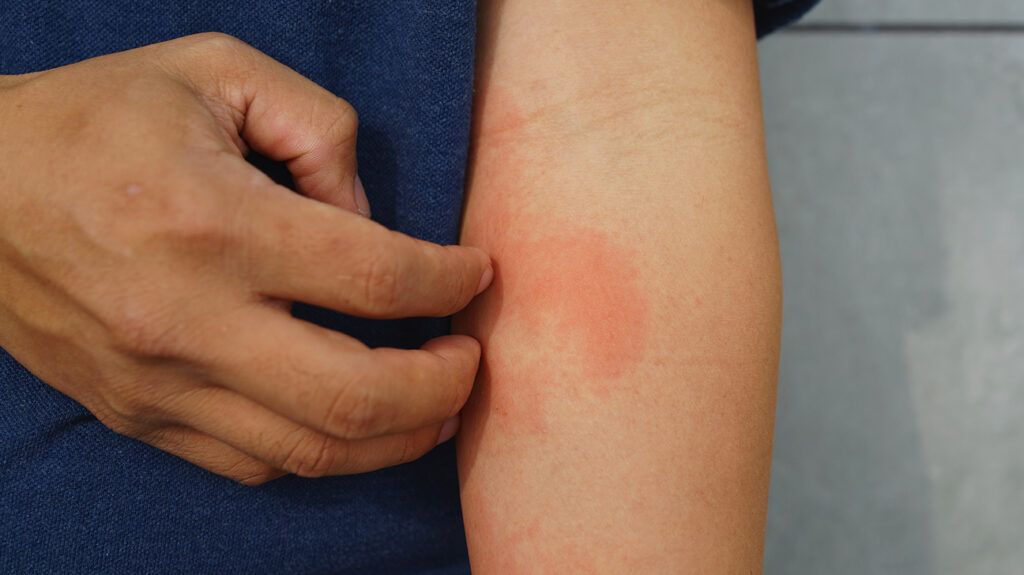An anxiety rash typically occurs as a result of stress or a preexisting skin condition. Deep breathing, avoiding tight clothes, or seeking professional support can provide relief.

We all know that certain plants, illnesses, and allergies can cause rashes, but what’s the connection between anxiety and rashes?
Skin discomfort, especially discomfort that comes along with anxiety, can be hard to deal with. The itching may sap your concentration. It could prevent sleep. You might feel self-conscious about the rash’s appearance or your constant scratching.
There are things you can do to help identify and address these rashes and ease the physical and emotional discomfort they bring.
Anxiety marks, sometimes called “stress rash” or “anxiety rash,” can happen when your body releases histamine in response to stress.
Histamine is the hormone that causes the symptoms of an allergic reaction. When it’s released in response to anxiety, an itchy, red reaction may form on the skin.
Sometimes, an anxiety rash is a flare-up of a skin condition you already have.
“If you have a skin rash or a skin condition, anxiety can bring it out and make it worse,” says Maya Jerath, a professor of medicine in the Division of Allergy & Immunology at Washington University in St. Louis. Jerath treats patients with allergies, so she’s seen plenty of rashes over her career.
Jerath explains that any major cause of stress — exam season, a loved one in the hospital, a demanding work project — can potentially trigger a flare of an existing skin condition.
Eczema patients, for example, sometimes notice their symptoms getting worse when they are anxious or stressed. The same is true for people with chronic hives, a condition where hives are present for longer than 6 weeks with no obvious cause.
Anxiety-related rashes aren’t limited to just eczema and hives. In fact, a
- rashes on the hands
- oily or flaky patches of skin
- hair loss
- pimples
- generally itchy skin
This indicates that several different skin issues appeared to be affected by their stress.
For some people, the itching and stress feed off of each other. “Itching itself will make anxiety worse, so it often ends up being this vicious cycle,” Jerath says. It can cause constant discomfort and interfere with sleep, which lowers your stress defenses further.
Another
Anxiety rashes often appear as hives. These slightly raised and itchy patches of skin usually look red. But they will blanch (turn white) or seem to disappear when you press on them. They may be small or join together to form large raised patches. Hives can happen anywhere on the body.
If you have a skin condition already, a stress flare-up will likely look like a worsening of your usual symptoms.
Anxiety may also bring other symptoms besides a rash:
- irritability
- headaches, muscle aches, stomach aches
- uncontrollable worry
- pounding heart or chest pain
- sweating and/or blushing
- trouble sleeping
Looking for relief from a stress rash? Here are some things to try.
One approach is to reduce the stress response in your body so that the histamine settles down.
“We can’t control everything that goes on in our lives,” says Jerath. “All we can focus on is stopping our response to [anxiety].”
A few ways to reduce the physical effects of anxiety and stress include:
- deep breathing
- getting enough sleep
- a calming yoga practice
- meditation
- calming teas
- relaxing music or books
Regular exercise can also help anxiety, but this is more of a preventive measure. Sometimes exercise and heat can make an existing rash worse.
If anxiety is a frequent problem, you could also consider speaking with a doctor or a therapist. They may suggest therapy, medication, lifestyle changes, or some combination to control your anxiety symptoms.
If the stress rash is a flare-up of a condition you already have, says Jerath, a doctor or allergist can suggest strategies to manage symptoms. If your condition is already being treated and your doctor has given you a symptom control plan, Jerath suggests sticking to that plan faithfully.
The American Academy of Dermatology lays out strategies for dealing with hives, specifically, including:
- keeping skin cool and comfortable
- avoiding tight clothes or straps
- cold compresses on the hives
- using over-the-counter anti-itch medication
- moisturizing regularly
You might consider seeking support if anxiety and stress are becoming a regular problem in your life. If you experience frequent symptoms of anxiety or stress rash, a doctor or therapist can help.
Jerath also encourages patients to visit their provider if they develop a rash that doesn’t respond to symptom control strategies that worked before. If symptoms increase and you just can’t get ahead of them, your doctor will likely want to know about it.
As we’ve seen, stress and anxiety can trigger rashes or flare-ups of existing skin conditions.
Anxiety and itchy, uncomfortable rashes can feed off of each other. Itching can make anxiety worse, and the worsening anxiety can make the rash worse. Addressing the source of stress in your life can have an impact on how often you get stress rashes and how severe they are.
Anxiety can also cause other symptoms like:
- irritability
- headache
- nausea
- worry
- a pounding heart
You might choose to treat your stress rash by diffusing the anxiety reaction in your body, reducing sources of stress in your life, or seeking help from a physical or mental health care professional.
If itchy, red skin is bothering you, there’s hope. Stress rashes can be controlled, possibly even prevented, by addressing stress in your life and seeking professional help.
